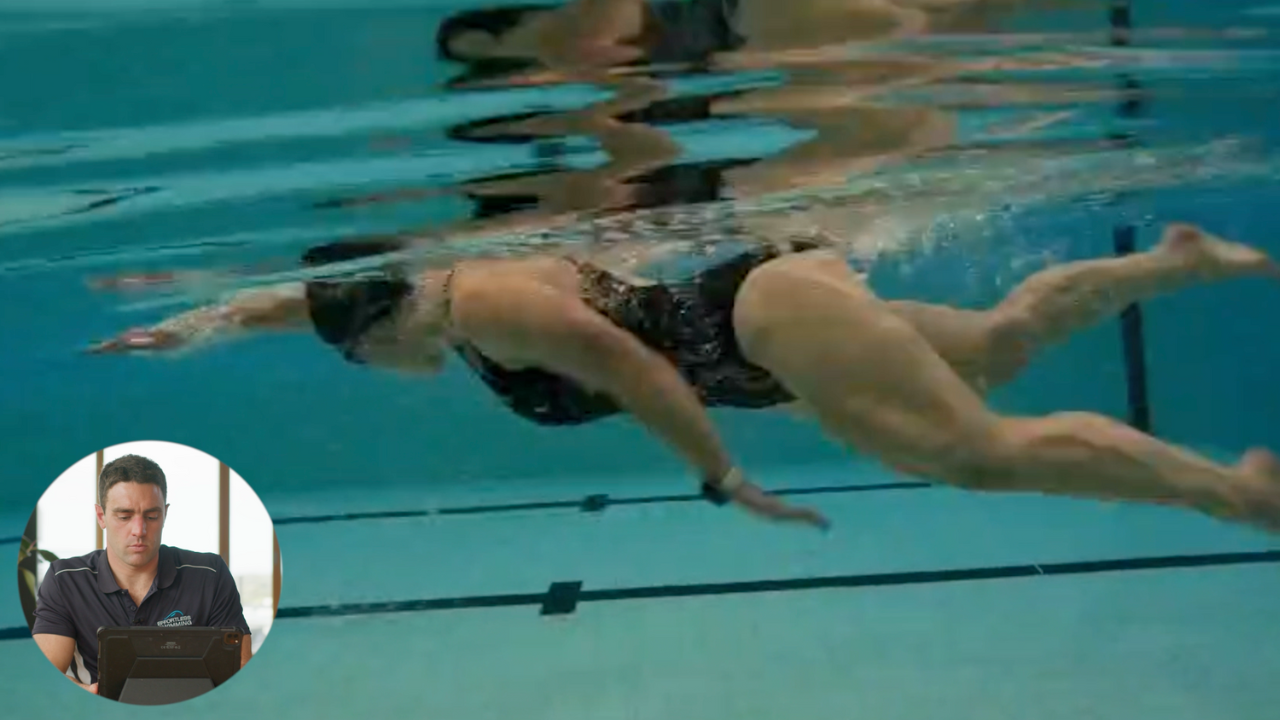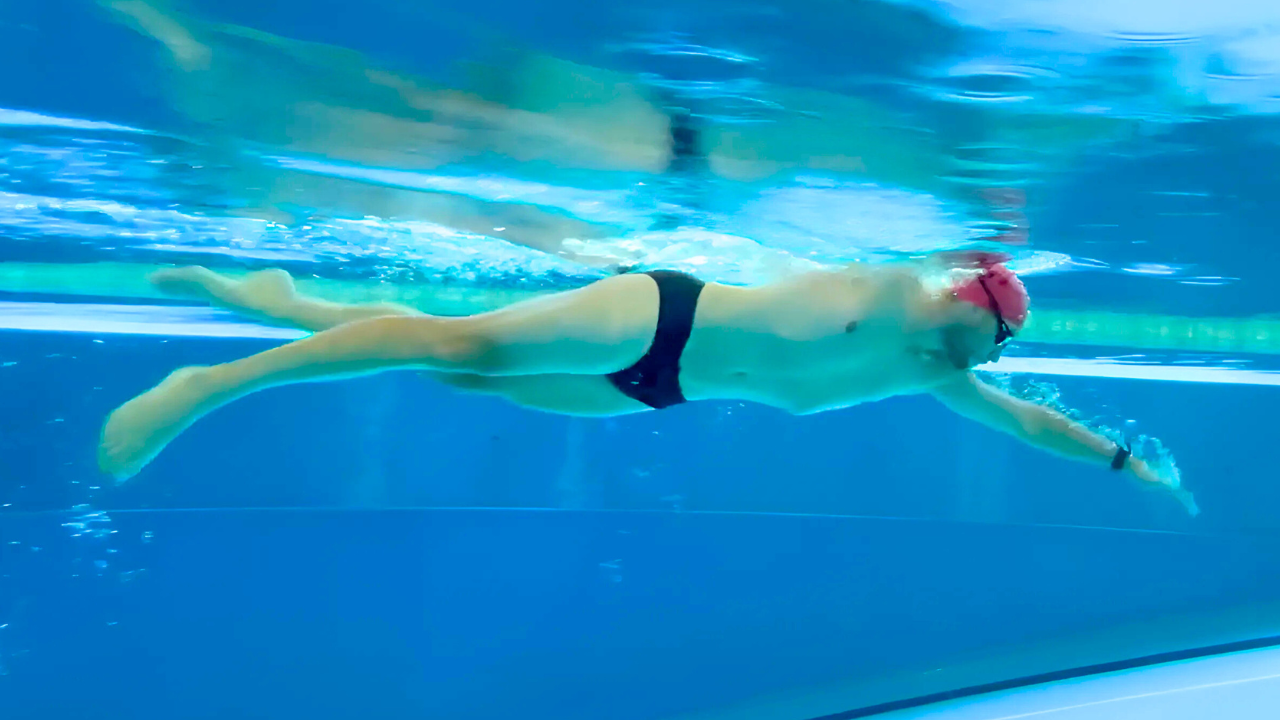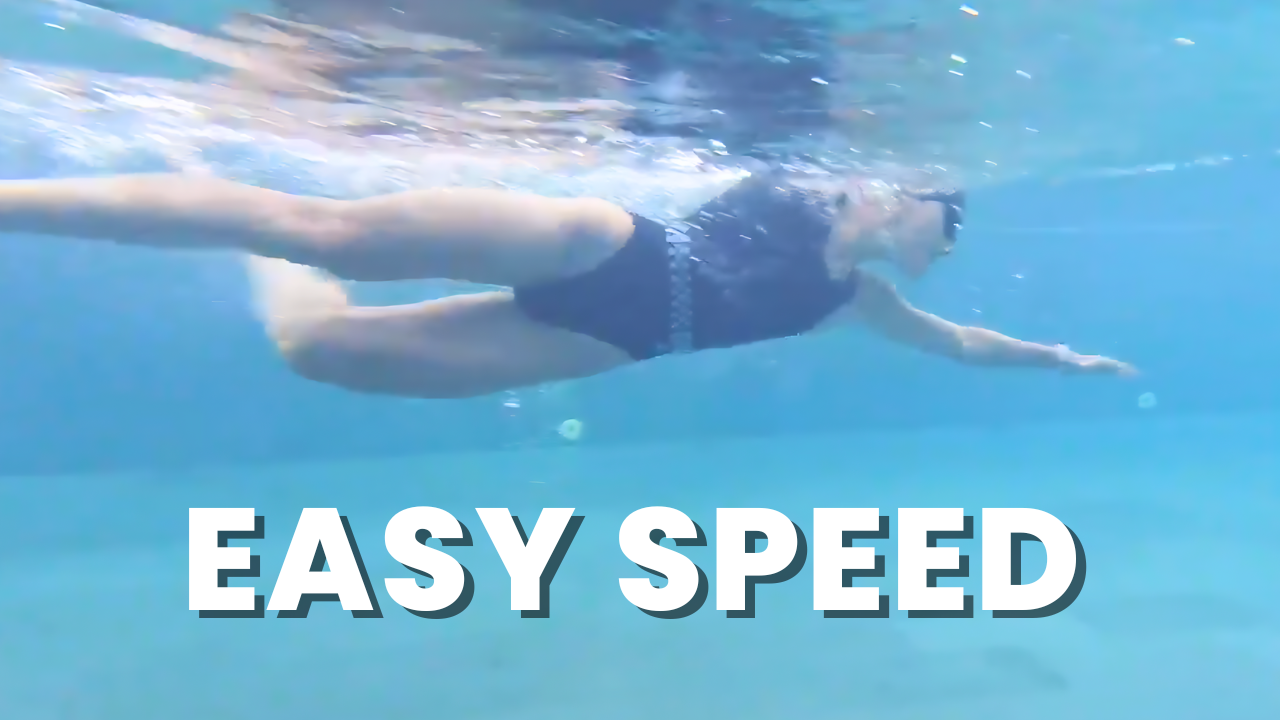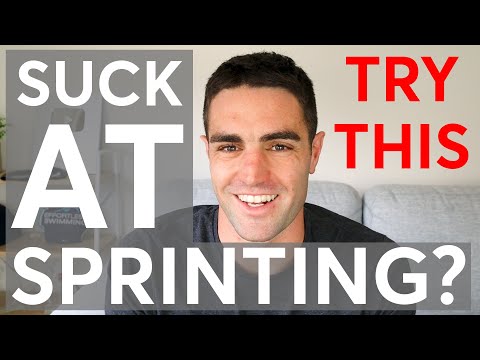This swimmer is doing a lot right, and with a few small tweaks to his technique, I believe he could quite easily knock 10 seconds of his 100m pace.
Transcription:
If you’re trying to get a good and strong powerful catch with this arm that’s in the water, but this arm is this far back here, it’s not a natural or comfortable position to be in. So it’s really compromising the catch there.
In this episode of Feedback Friday we have a swimmer who is swimming around the 150 to 155 mark per 100, and what you’ll notice here is there’s a couple of things that this swimmer could tweak and change slightly that’s going to put him in a much more natural, much more comfortable position in the water, which will help him increase his stroke rate, but also get into some better positions that will help him swim faster.
Now, there’s a couple of things here that I’ll point out that I think would fairly quickly get this swimmer under the 145, maybe under the 140 mark in the case of maybe a couple of weeks or two to three months’ time. Because there’s a lot this swimmer is doing well, but there are some things in the stroke that are just slowing him down and limiting his ability to really get the most out of the good things that he’s doing in his stroke.
So what you’ll notice here from above is there’s quite a bit of snaking going on through the body when we look from above. Now, the first thing that I’ll point out with that is head position. So you’ll see here, and it’s quite evident from that very first shot that we had, the swimmer’s looking a little bit too far forwards. And as you know, there’s nothing wrong with looking somewhat forwards. Up to about 45 degrees is where we like to see often triathletes and open water swimmers because it gives you that awareness about what’s coming up in front of you. But if you do look too far forwards and there’s a big kink in the neck, as in we’ve got the spine here and then the head really comes up and it’s a very sort of sharp angle, that’s a very unnatural and uncomfortable position. So the neck should be kept neutral, as in fairly straight, and you can still do that when you look somewhat forwards. But this swimmer’s just looking a little bit too far forwards.
So if you imagine walking around the street for an hour and looking straight up at the sky, you’re probably going to get pretty tight, pretty sore through the neck and through the upper traps there. And there’s a good chance that this swimmer might really feel it through the upper traps after a swim. We’ve had a lot of swimmers come to clinics, a lot of swimmers who have sent their videos in through the membership and they’ve had really tight upper traps because of that head position. And then as soon as they change it, it just takes the pressure off and it means that they can swim more if they want to or they don’t pull up as sore afterward.
So first thing here, I’d look to look slightly further down and still keep the crown of the head out of the water, but the way I like to think of this and we explain this at our clinics and camps is keep the neck long. Like you’ve got a piece of string through the spine, through the neck and that piece of string is being pulled in that direction. So imagine that there’s someone here, they’re pulling that piece of string towards them and you want to really lengthen out through the spine and through neck there. And that can allow you to keep that neutral position, that straighter position. That will be the first thing. That will get him somewhere in a slightly better body position in terms of the straightness through the body.
So in general, we want to try and get rid of most of this sort of snaking side to side. You do see it a little bit in some distance swimmers like with Gregorio Paltrinieri. He does have a little bit of curve through there. But in general, we want to try and keep it fairly, fairly straight.
Now, one of the things that I reckon is probably causing him to have a bit of this snaking position. So one of them is where he’s turning his head to breathe. You’ll see that right here, this is nice, straight through here. It’s like he’s got this narrow corridor that he’s swimming down. But as he turns his head to breathe, the head’s just turning off to the side a little bit too much there. So we had the spine here and then the head’s really kicked off to the side there. So what he may need to do is just get that breathing position to be a lot straighter.
So if you imagine that you’ve got this skewer that runs through your spine, through your neck there, like a chicken skewer, and when you turn your head to breathe it stays on that skewer, which means the head should stay centered. As soon as that head’s going to come off to the side, well, the rest of the body is going to sort of following that path. The head’s like the steering wheel for the rest of the body, and so you’ll see that it sort of comes around as a result of it. And in terms of drag, you look at how much more space he’s now taking up in the water compared to what was about that before. So what we’d start with is head position and breathing position.
Now, in terms of fixing this breathing position, a couple of ways you can go about it. You can do the kick on side or the side kicking drill, which you can see here. With this side kicking drill the aim would be to keep the head centered when you turn to breathe. Otherwise, you’re looking straight down. Or you can do the FKB drill, which is the front kick breathe drill that we’ve got in the video membership there. And that’s what I give a lot of swimmers who are struggling with their breathing. Either if they’re rotating their shoulders too far or if they can’t keep their head centered. So that’s quite a good one to do. Either of those two drills would be good ones to fix it.
Now, the other thing that we might be looking at here to help keep the body straighter, straighter through the hips, is possibly reaching a little bit less. Now, this is something that’s somewhat hard to see. You can just kind of have a guess at it without talking to this swimmer, but you can see that the swimmer may be reaching a little far forwards here and potentially pressing back a little bit too far there.
So yes, you want to stay longer when you swim, but you don’t want to be as long as you possibly can because that’s going to throw the balance off. And quite often I’ve had swimmers who’ve come to clinics and they’ve been told you need to reach as far as you possibly can forward, but it’s not the case. Like with anything, like with running, you don’t want to have as long a strides as you possibly can because that’s going to overstretch you. That’s going to put you in positions that aren’t comfortable and aren’t natural.
So yes, you want a long stride, but you don’t want to overdo it. Same thing in swimming here and there’s a really good chance that this swimmer might just be reaching out a little bit too far there. So if this is 100% of his capable reach, what I like to recommend there is bring it back to 95%. And that will then still keep you controlled, you’ll be balanced and you’ll also be able to be a lot stronger through those movements there. Because at full extension, good luck trying to be strong through the shoulders and the back there.
Now, the other thing that you’ll see here is that with this left arm recovery, you’ll notice that he’s quite jammed up through there. Very jammed up through the shoulders. So he’s probably coming a little bit too close to the body there, and you’ll also see that it’s a, what we call a hand-led recovery. So through here, it’s almost like the elbow gets left behind. So that there stays in the same position for quite a while, while the hand swings forward. So we call that a hand-led recovery. We want to change that to an elbow-led recovery, which just means from here to here, so once you get to the shoulders, so from there to there, really the elbow should be leading the way from there to there.
Because if you’re trying to bring the arm forwards using the hand here through the whole stroke there, then it can put you in that sort of jammed up position, and it just means… I’ll see if I can show you here. It’s the left one. As a coach, we should be able to see your underarm as you’re coming over the top. And if we could see on this side view here, it’s unlikely we could actually see his underarm there. So it just means that he’s not coming over that well in the recovery. With this right arm, there’s a couple of things we’d changed, but that’s better. We want to be able to see the underarm at least partly in that recovery, but it’s not happening on that left arm.
So what can you do to fix it? A number of drills you can do. One that we often do at clinics is the one you can see here, which I’ll play now. So this kick board press down drill can be a very good drill to help with changing or fixing that recovery. So we’ve looked at that.
The other thing that he may need to adjust is that right arm recovery. So looking from above here… or sorry, the front-on view. As he comes over, you’ll notice that this elbow… So if this is the center of his body, the elbow is actually coming behind that centerline. So he’s just over-rotating on that breathing stroke. There’s nothing wrong with coming over high over the water, even somewhat straight arm. That can work really well for open water, triathlon. It can be very effective. But here he’s just come back a bit too far. So where he may be best off is somewhere out there. That’s a much more natural, much more comfortable position to be in there. So just over-rotating. And again, if you’re trying to get a good and strong powerful catch with this arm that’s in the water, but this arm is this far back here, it’s not a natural or comfortable position to be in. So it’s really compromising the catch there.
Now, the last thing I’ll show you here is the catch in the pool. And there are some really good aspects that this swimmer’s got in the catch in the pool, just needs to adjust it slightly. So from the… I think we get a side view here. Yeah, this is pretty good. Now, great starting catch position. So the hand enters here, fingers first. It’s good. He’s sliding the hand forwards and the position that he’s going to start the catch is fingers below the wrist, wrist below elbow. That looks great. Good position that he’s currently in. Then he’s setting up the catch pretty well. He’s getting the fingertips to point down and probably getting in a pretty good high elbow catch position. And the forearm and hand are working together there to press back well.
Now, from here the thing he just needs to change really is going a bit deeper. So from there to there, you’ll see that the hand pretty much… it moves straight back from there to there. And if we look at this position in terms of, all right, what’s the angle? It is roughly 90 degrees. Roughly 90 degrees. That needs to be 100 to 120. Somewhere in that range is a lot stronger, a lot more powerful. And quite often, when people are working on their high elbow catch, they think that high elbow means this part of the arm or the elbow needs to be high, needs to be close to the surface. That’s not the case.
And sometimes they also think that when they do their pull through that they’re better off basically being really shallow with it. But again, that’s not the case. You actually see with those really, really good swimmers, this position, it’s kind of like that, but he just needs to get a little bit deeper because if he wants to be powerful, if he wants to be strong for very little effort there, then he just needs to get the hand down deeper and get that angle of 100 to 120 through here. And the way we see it is as you’re about to pass under the shoulder there, the arm should make this diamond sort of shape or half diamond shape. But if you’ve got both arms, it will look like a diamond. You’ve probably seen it in some of the other videos that we’ve done. We talk about the power diamond there. And for this swimmer to get that diamond, he’s just got to go a little bit deeper.
Now, what it will feel like for him when he changes it, and we’ve seen this so many times at the clinics that we do and when I coach people online is you’re going to have to make that feel ridiculously deep. So for him to get to the right position, I can guarantee you he will have to feel like he’s probably going all the way down here, almost like he’s probably pulling straight through. Because oftentimes with the arms, anything that happens out in front of the head and sometimes under the body needs to be exaggerated to the point that it feels ridiculous to actually change it. So just prepare yourself to really have to overdo the thing that we’re looking to change there.
Left arm, again, nice position here that he’s starting with, starting to catch in. Setting up really nicely. Those fingertips are pointing down well. He can seize in this high elbow catch position, which is great. And again, just going too shallow. You can see how he’s actually coming up towards the surface through that part. Know from there to there you’ve still got to keep moving downward slightly. We can’t really get the angle there but it’s just going too shallow.
So overall or in general, I’d get him to feel like he’s going fairly deep with the arms as he’s about… Once he gets to here, he’s got to feel like he’s going quite deep because it’s just too shallow there. And what we often see with people who are going too shallow there is they go very wide. So from here to here, you’ll notice that the hand is moving away from the body slightly there, which means from here back to the hip, notice how that palm of the hand is coming in towards the body there to there. So he’s not getting much propulsion out of that last part because the palm of the hand is really facing inwards. We need that to have more of an in sweep, come in, finish closer to the hip.
So it should be… I’ll draw it from above because this would be a better angle, but… All right, so see it with the left arm? So he starts here, all right? Then what we want it to do is sort of come away from the center a little bit, then come in next to the hip. It’s like a really long S shape if we trace the hand. Now you’ll see that this left hand comes out, and see how it’s still going wider there? So it basically goes like this outwards and then it comes back into the body. So we just really need to get it in closer in that back part.
So how could he change that? Well, we’ve actually had a number of swimmers… I think there have been about three swimmers lately who we’ve worked on this exit with inside the membership. And the drill that I gave them, there was a couple, but some of the drills that I gave them, one of them was YMCA drill, which you can see here. This is one that you’ve probably seen before if you’ve watched any of our Feedback Friday videos. The other one is top to bottom scull, which is very similar to YMCA drill, but you’re basically sculling from the front of the stroke all the way to the back. And the focus with that drill is that when you go to through the back part, so when you go from here to here, when you’re going through that scull, really get in a lot closer under the body there. Because they’ll probably find that when they start doing that drill they’ll be out too wide.
Now, and the other drill that you can do, which is quite helpful is the tricep extension drill. Again, you might’ve seen this in some of our videos, but in that tricep extension drill, it just gets you really good at keeping the upper arm in close to the ribs at the back and just practice finishing past the hip there. So you just want to use whichever drills work for you. You might choose one of those drills, you might do all three and just see which ones work best for you. But as you can see, it doesn’t or it won’t take a lot for this guy to be able to get down under that 145, 140 marks fairly consistently by being able to tweak a few aspects of his stroke here. And like anything that you’re trying to change, it will take at least a couple of weeks to make it a bit of a habit, to have it feel normal and natural. But with a lot of people, there is some sort of easy wins that they can have.
So if you did enjoy this video, please like and subscribe. And if you are looking to improve your own stroke, we help swimmers… Well, I help swimmers by coaching them online, so you can send your own videos and I’ll analyze it. I’ll give you specific drills and things to focus on, and we have several hundred people who do that online. I’ll put the link below to our membership where you’re able to do that. Thanks so much for watching and I’ll see you next week with another Feedback Friday.










